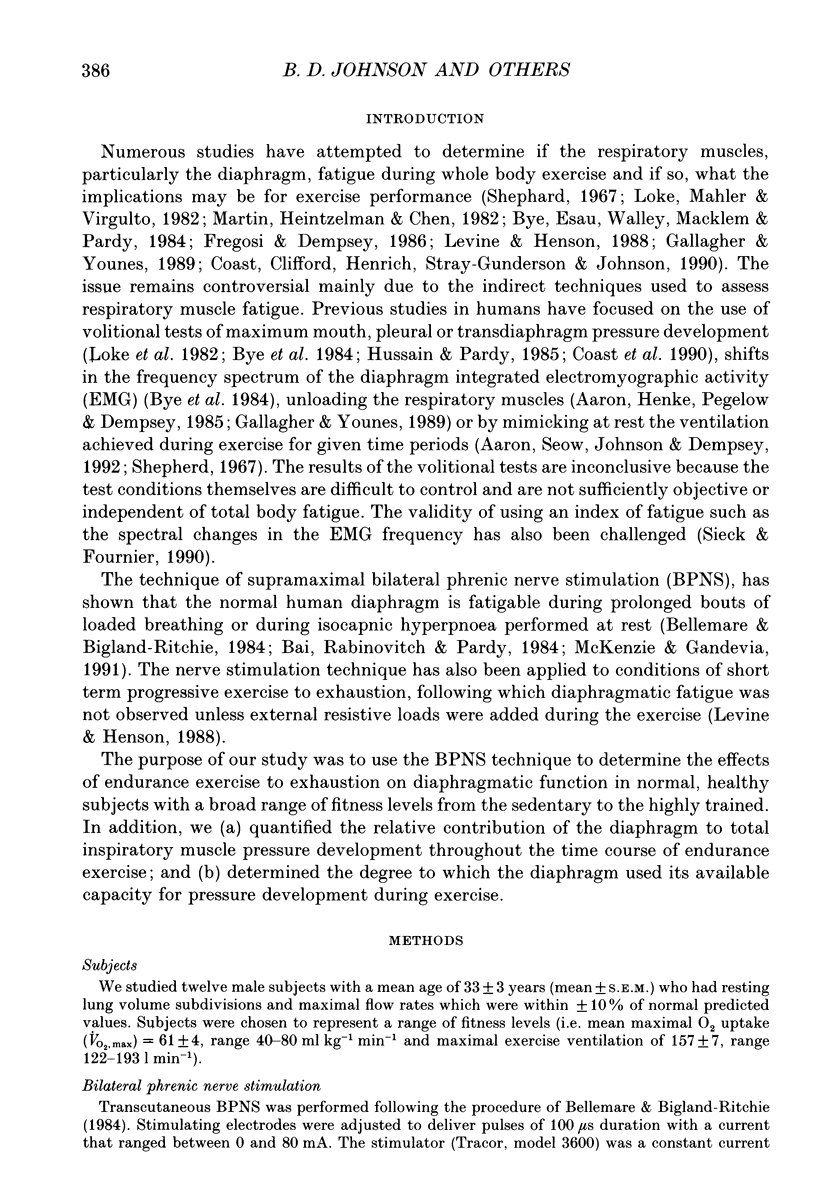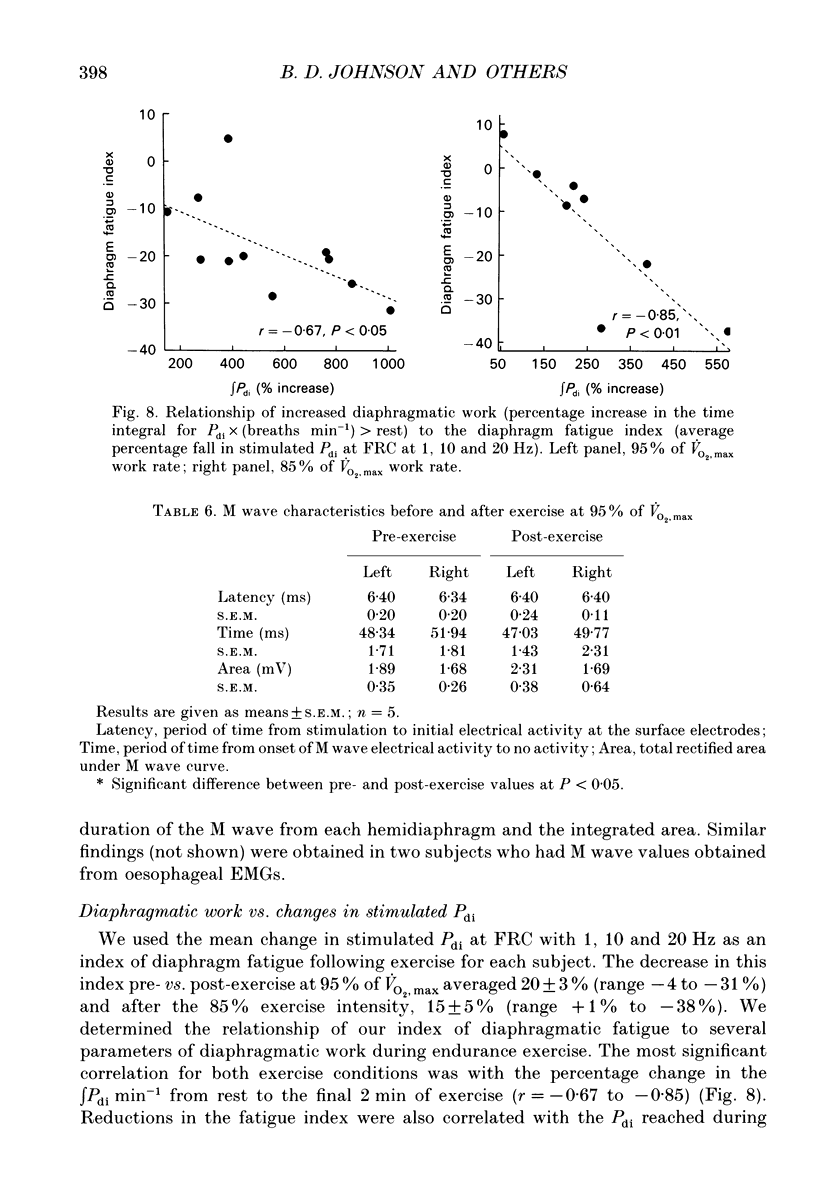Abstract
1. Twelve healthy subjects (33 +/- 3 years) with a variety of fitness levels (maximal oxygen uptake (VO2, max) = 61 +/- 4 ml kg-1 min-1, range 40-80), exercised at 95 and 85% VO2, max to exhaustion (mean time = 14 +/- 3 and 31 +/- 8 min, expired ventilation (VE) over final minute of exercise = 149 +/- 9 and 126 +/- 10 l min-1). 2. Bilateral transcutaneous supramaximal phrenic nerve stimulation (BPNS) was performed before and immediately after exercise at four lung volumes, and 400 ms tetanic stimulations were performed at 10 and 20 Hz. The coefficients of variation of repeated measurements for the twitch transdiaphragm pressures (Pdi) were +/- 7-10% and for compound muscle action potentials (M wave) +/- 10-15%. 3. Following exercise at 95% of VO2, max, group mean Pdi twitch values were reduced at all lung volumes (range -8 +/- 3 to -32 +/- 5%) and tetanically stimulated Pdi values were reduced at both 10 and 20 Hz (-21 +/- 3 and -13 +/- 2%, respectively) (P = 0.001-0.047). Following exercise at 85% VO2, max, stimulated Pdi values were reduced at all lung volumes and stimulating frequencies, but only significantly so with the twitch at functional residual capacity (-15 +/- 5%). Stimulated Pdi values recovered partially by 30 min post-exercise and almost completely by an average time of 70 min. 4. The fall in stimulated Pdi values post-exercise was significantly correlated with the percentage increase in diaphragmatic work (integral of Pdi min-1) from rest to end-exercise and the relative intensity of the exercise. 5. The integral of Pdi min-1 and the integral of Po min-1 (Po, esophageal pressure) rose together from rest through the fifth to tenth minute of exercise, after which integral of Pdi min-1 plateaued even though integral of Po min-1, VE and inspiratory flow rate all continued to rise substantially until exercise terminated. Thus, the relative contribution of the diaphragm to total respiratory motor output was progressively reduced with exercise duration. 6. We conclude that significant diaphragmatic fatigue is caused by the ventilatory requirements imposed by heavy endurance exercise in healthy persons with a variety of fitness levels. The magnitude of the fatigue and the likelihood of its occurrence increases as the relative intensity of the exercise exceeds 85% of VO2, max.
Full text
PDF




















Selected References
These references are in PubMed. This may not be the complete list of references from this article.
- Aaron E. A., Seow K. C., Johnson B. D., Dempsey J. A. Oxygen cost of exercise hyperpnea: implications for performance. J Appl Physiol (1985) 1992 May;72(5):1818–1825. doi: 10.1152/jappl.1992.72.5.1818. [DOI] [PubMed] [Google Scholar]
- Bai T. R., Rabinovitch B. J., Pardy R. L. Near-maximal voluntary hyperpnea and ventilatory muscle function. J Appl Physiol Respir Environ Exerc Physiol. 1984 Dec;57(6):1742–1748. doi: 10.1152/jappl.1984.57.6.1742. [DOI] [PubMed] [Google Scholar]
- Bellemare F., Bigland-Ritchie B. Assessment of human diaphragm strength and activation using phrenic nerve stimulation. Respir Physiol. 1984 Dec;58(3):263–277. doi: 10.1016/0034-5687(84)90003-3. [DOI] [PubMed] [Google Scholar]
- Bellemare F., Bigland-Ritchie B. Central components of diaphragmatic fatigue assessed by phrenic nerve stimulation. J Appl Physiol (1985) 1987 Mar;62(3):1307–1316. doi: 10.1152/jappl.1987.62.3.1307. [DOI] [PubMed] [Google Scholar]
- Bellemare F., Garzaniti N. Failure of neuromuscular propagation during human maximal voluntary contraction. J Appl Physiol (1985) 1988 Mar;64(3):1084–1093. doi: 10.1152/jappl.1988.64.3.1084. [DOI] [PubMed] [Google Scholar]
- Bellemare F., Grassino A. Effect of pressure and timing of contraction on human diaphragm fatigue. J Appl Physiol Respir Environ Exerc Physiol. 1982 Nov;53(5):1190–1195. doi: 10.1152/jappl.1982.53.5.1190. [DOI] [PubMed] [Google Scholar]
- Bye P. T., Esau S. A., Walley K. R., Macklem P. T., Pardy R. L. Ventilatory muscles during exercise in air and oxygen in normal men. J Appl Physiol Respir Environ Exerc Physiol. 1984 Feb;56(2):464–471. doi: 10.1152/jappl.1984.56.2.464. [DOI] [PubMed] [Google Scholar]
- Coast J. R., Clifford P. S., Henrich T. W., Stray-Gundersen J., Johnson R. L., Jr Maximal inspiratory pressure following maximal exercise in trained and untrained subjects. Med Sci Sports Exerc. 1990 Dec;22(6):811–815. doi: 10.1249/00005768-199012000-00013. [DOI] [PubMed] [Google Scholar]
- Collett P. W., Perry C., Engel L. A. Pressure-time product, flow, and oxygen cost of resistive breathing in humans. J Appl Physiol (1985) 1985 Apr;58(4):1263–1272. doi: 10.1152/jappl.1985.58.4.1263. [DOI] [PubMed] [Google Scholar]
- Davies C. T., White M. J. Muscle weakness following dynamic exercise in humans. J Appl Physiol Respir Environ Exerc Physiol. 1982 Jul;53(1):236–241. doi: 10.1152/jappl.1982.53.1.236. [DOI] [PubMed] [Google Scholar]
- Dodd D. S., Collett P. W., Engel L. A. Influence of inspiratory flow rate and frequency on O2 cost of resistive breathing in humans. J Appl Physiol (1985) 1988 Aug;65(2):760–766. doi: 10.1152/jappl.1988.65.2.760. [DOI] [PubMed] [Google Scholar]
- Esau S. A., Bye P. T., Pardy R. L. Changes in rate of relaxation of sniffs with diaphragmatic fatigue in humans. J Appl Physiol Respir Environ Exerc Physiol. 1983 Sep;55(3):731–735. doi: 10.1152/jappl.1983.55.3.731. [DOI] [PubMed] [Google Scholar]
- Fitzgerald R. S., Hauer M. C., Bierkamper G. G., Raff H. Responses of in vitro rat diaphragm to changes in acid-base environment. J Appl Physiol Respir Environ Exerc Physiol. 1984 Oct;57(4):1202–1210. doi: 10.1152/jappl.1984.57.4.1202. [DOI] [PubMed] [Google Scholar]
- Fregosi R. F., Dempsey J. A. Effects of exercise in normoxia and acute hypoxia on respiratory muscle metabolites. J Appl Physiol (1985) 1986 Apr;60(4):1274–1283. doi: 10.1152/jappl.1986.60.4.1274. [DOI] [PubMed] [Google Scholar]
- Gallagher C. G., Younes M. Effect of pressure assist on ventilation and respiratory mechanics in heavy exercise. J Appl Physiol (1985) 1989 Apr;66(4):1824–1837. doi: 10.1152/jappl.1989.66.4.1824. [DOI] [PubMed] [Google Scholar]
- Hanson P., Claremont A., Dempsey J., Reddan W. Determinants and consequences of ventilatory responses to competitive endurance running. J Appl Physiol Respir Environ Exerc Physiol. 1982 Mar;52(3):615–623. doi: 10.1152/jappl.1982.52.3.615. [DOI] [PubMed] [Google Scholar]
- Henke K. G., Sharratt M., Pegelow D., Dempsey J. A. Regulation of end-expiratory lung volume during exercise. J Appl Physiol (1985) 1988 Jan;64(1):135–146. doi: 10.1152/jappl.1988.64.1.135. [DOI] [PubMed] [Google Scholar]
- Hubmayr R. D., Litchy W. J., Gay P. C., Nelson S. B. Transdiaphragmatic twitch pressure. Effects of lung volume and chest wall shape. Am Rev Respir Dis. 1989 Mar;139(3):647–652. doi: 10.1164/ajrccm/139.3.647. [DOI] [PubMed] [Google Scholar]
- Hussain S. N., Pardy R. L. Inspiratory muscle function with restrictive chest wall loading during exercise in normal humans. J Appl Physiol (1985) 1985 Jun;58(6):2027–2032. doi: 10.1152/jappl.1985.58.6.2027. [DOI] [PubMed] [Google Scholar]
- Jammes Y., Buchler B., Delpierre S., Rasidakis A., Grimaud C., Roussos C. Phrenic afferents and their role in inspiratory control. J Appl Physiol (1985) 1986 Mar;60(3):854–860. doi: 10.1152/jappl.1986.60.3.854. [DOI] [PubMed] [Google Scholar]
- Johnson B. D., Reddan W. G., Seow K. C., Dempsey J. A. Mechanical constraints on exercise hyperpnea in a fit aging population. Am Rev Respir Dis. 1991 May;143(5 Pt 1):968–977. doi: 10.1164/ajrccm/143.5_Pt_1.968. [DOI] [PubMed] [Google Scholar]
- Johnson B. D., Seow K. C., Pegelow D. F., Dempsey J. A. Adaptation of the inert gas FRC technique for use in heavy exercise. J Appl Physiol (1985) 1990 Feb;68(2):802–809. doi: 10.1152/jappl.1990.68.2.802. [DOI] [PubMed] [Google Scholar]
- Jones D. A. Muscle fatigue due to changes beyond the neuromuscular junction. Ciba Found Symp. 1981;82:178–196. doi: 10.1002/9780470715420.ch11. [DOI] [PubMed] [Google Scholar]
- Laporta D., Grassino A. Assessment of transdiaphragmatic pressure in humans. J Appl Physiol (1985) 1985 May;58(5):1469–1476. doi: 10.1152/jappl.1985.58.5.1469. [DOI] [PubMed] [Google Scholar]
- Levine S., Henson D. Low-frequency diaphragmatic fatigue in spontaneously breathing humans. J Appl Physiol (1985) 1988 Feb;64(2):672–680. doi: 10.1152/jappl.1988.64.2.672. [DOI] [PubMed] [Google Scholar]
- Loke J., Mahler D. A., Virgulto J. A. Respiratory muscle fatigue after marathon running. J Appl Physiol Respir Environ Exerc Physiol. 1982 Apr;52(4):821–824. doi: 10.1152/jappl.1982.52.4.821. [DOI] [PubMed] [Google Scholar]
- McCool F. D., McCann D. R., Leith D. E., Hoppin F. G., Jr Pressure-flow effects on endurance of inspiratory muscles. J Appl Physiol (1985) 1986 Jan;60(1):299–303. doi: 10.1152/jappl.1986.60.1.299. [DOI] [PubMed] [Google Scholar]
- McCool F. D., Tzelepis G. E., Leith D. E., Hoppin F. G., Jr Oxygen cost of breathing during fatiguing inspiratory resistive loads. J Appl Physiol (1985) 1989 May;66(5):2045–2055. doi: 10.1152/jappl.1989.66.5.2045. [DOI] [PubMed] [Google Scholar]
- McKenzie D. K., Gandevia S. C. Recovery from fatigue of human diaphragm and limb muscles. Respir Physiol. 1991 Apr;84(1):49–60. doi: 10.1016/0034-5687(91)90018-e. [DOI] [PubMed] [Google Scholar]
- Olafsson S., Hyatt R. E. Ventilatory mechanics and expiratory flow limitation during exercise in normal subjects. J Clin Invest. 1969 Mar;48(3):564–573. doi: 10.1172/JCI106015. [DOI] [PMC free article] [PubMed] [Google Scholar]
- Shephard R. J. The maximum sustained voluntary ventilation in exercise. Clin Sci. 1967 Apr;32(2):167–176. [PubMed] [Google Scholar]
- Sieck G. C., Fournier M. Changes in diaphragm motor unit EMG during fatigue. J Appl Physiol (1985) 1990 May;68(5):1917–1926. doi: 10.1152/jappl.1990.68.5.1917. [DOI] [PubMed] [Google Scholar]
- Sieck G. C., Fournier M. Diaphragm motor unit recruitment during ventilatory and nonventilatory behaviors. J Appl Physiol (1985) 1989 Jun;66(6):2539–2545. doi: 10.1152/jappl.1989.66.6.2539. [DOI] [PubMed] [Google Scholar]
- Thomas C. K., Woods J. J., Bigland-Ritchie B. Impulse propagation and muscle activation in long maximal voluntary contractions. J Appl Physiol (1985) 1989 Nov;67(5):1835–1842. doi: 10.1152/jappl.1989.67.5.1835. [DOI] [PubMed] [Google Scholar]


